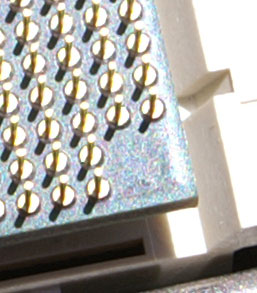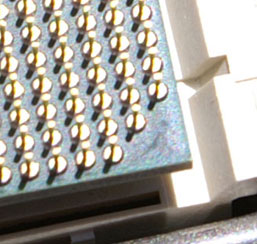AMD Socket-AM2: Same Performance, Faster Memory, Lower Power
by Anand Lal Shimpi on May 23, 2006 12:14 PM EST- Posted in
- CPUs
AM2 in Detail
Of course the most prominent feature of AMD's Socket-AM2 platform is the new socket and its support for DDR2 memory. As we've already mentioned, Socket-AM2 is a 940-pin socket that is keyed differently from the original 940-pin Athlon 64/Opteron sockets; only AM2 processors will physically fit into an AM2 motherboard.

Socket-939 (left) vs. Socket-AM2 (right)
Socket-939 |
Socket-AM2 |
 |
 |
One of the Athlon 64's strongest selling points continues to be its on-die memory controller, which has of course been significantly changed for the new Socket-AM2 platform. All AM2 CPUs feature a 128-bit wide DDR2 memory controller, compared to the 128-bit DDR memory controller that we've come to know from the Socket-939 platform. A DDR2 memory interface actually requires more pins than a DDR1 interface, but AMD was able to keep the AM2 pin count down by removing a large number of unnecessary pins on the Athlon 64's package. When the Socket-940/939 Athlon 64s were first designed, approximately 10% of their pins were redundant and could be removed in later designs. Not desiring to introduce a new socket as frequently as its competition had, AMD waited until Socket-AM2 to remove those unnecessary pins thus enabling a dual-channel DDR2 interface in virtually the same pin count as the earlier DDR1 equipped CPUs.
All of the Socket-AM2 CPUs support up to DDR2-667, but the AM2 Athlon 64 X2 and Athlon 64 FX models support up to DDR2-800. Since Socket-AM2 unifies AMD's desktop socket strategy, all Semprons, Athlon 64s, X2s and FX processors will feature this dual channel DDR2 memory controller.

Corsair partnered with AMD and NVIDIA for the Socket-AM2 and nForce 500 review kits
The lineup of Socket-AM2 processors being introduced today are in the table below:
| CPU | Clock Speed | L2 Cache Size | TDP | Price |
| AMD Athlon 64 FX-62 | 2.8GHz | 1MBx2 | 125W | $1031 |
| AMD Athlon 64 X2 5000+ | 2.6GHz | 512KBx2 | 89W | $696 |
| AMD Athlon 64 X2 4800+ | 2.4GHz | 1MBx2 | 89W | $645 |
| AMD Athlon 64 X2 4600+ | 2.4GHz | 512KBx2 | 89W | $558 |
| AMD Athlon 64 X2 4400+ | 2.2GHz | 1MBx2 | 89W | $470 |
| AMD Athlon 64 X2 4200+ | 2.2GHz | 512KBx2 | 89W | $365 |
| AMD Athlon 64 X2 4000+ | 2.0GHz | 1MBx2 | 89W | $328 |
| AMD Athlon 64 X2 3800+ | 2.0GHz | 512KBx2 | 89W | $303 |
| AMD Athlon 64 3800+ | 2.4GHz | 512KB | 62W | $290 |
| AMD Athlon 64 3500+ | 2.2GHz | 512KB | 62W | $189 |
| AMD Sempron 3600+ | 2.0GHz | 256KB | 62W | $123 |
| AMD Sempron 3500+ | 2.0GHz | 128KB | 62W | $109 |
| AMD Sempron 3400+ | 1.8GHz | 256KB | 62W | $97 |
| AMD Sempron 3200+ | 1.8GHz | 128KB | 62W | $87 |
| AMD Sempron 3000+ | 1.6GHz | 256KB | 62W | $77 |
There's basically no price premium for the new Socket-AM2 chips, encouraging a quick transition to AMD's new DDR2 platform.
You will also notice that none of the model numbers have changed, so an Athlon 64 X2 4800+ on Socket-AM2 has the same clock speed and L2 cache size as the Socket-939 version. Since AMD's model numbers haven't changed, you already know not to expect any major changes in performance with Socket-AM2. In fact, the only difference on the CPU side is the introduction of the new Athlon 64 FX-62, Athlon 64 X2 5000+ and Athlon 64 X2 4000+.










83 Comments
View All Comments
darkdemyze - Tuesday, May 23, 2006 - link
z-ram isn't due for AMD procs for quite some time, I doubt this is their plan for June..mlittl3 - Tuesday, May 23, 2006 - link
Basically this is what I said above for my guess of the "trick" AMD will use. Anand said it will only affect some high-end users, read FX series so it can't be price cuts as some have suggested (that would effect everyone). Adding L3 cache is the only performance improvement I can think of that doesn't require changing the microarchitecture of the cores (well at least not a big change).However, TDP is still an issue here as someone above suggested. I don't know how much more power it takes to run L3 cache. Last time AMD did it was on K6 and power wasn't really measured back then.
By the way, please ignore Questar's comment below about z-ram being pig slow. I really don't think he knows what he is talking about. /shields eyes from incoming Questar flame
johnsonx - Wednesday, May 24, 2006 - link
K6-III did not have L3 cache. It had L2 cache, making the cache that all socket-7 boards had then an L3 cache.So, let's stop saying things like 'AMD hasn't done L3 cache since K6-III', etc.
mino - Wednesday, May 24, 2006 - link
Well, IMHO the point is AMD has used exclusive 3-level cache structure in the past so they have som experience with thi arrangement.Questar - Tuesday, May 23, 2006 - link
No flame here, look it up for yourself.Z-RAM has high capacitive loading, which results in slow speed.
At 4MB it'll run half the speed of SRAM.
Questar - Tuesday, May 23, 2006 - link
Large amounts of Z-RAM are pig slow.Ecmaster76 - Tuesday, May 23, 2006 - link
Seriously, the one area an Athlon X2 would be bandwidth starved and does it get tested in the preview? NOIn the review? NO
How long ago did we know that the K8 was not bandwidth limited in single application usage? YEARS
So yeah, DDR2 din't increase the 3dMark, big surprise
mlittl3 - Tuesday, May 23, 2006 - link
I think 3dMark06 is multithreaded now so all available cores and bandwidth should be used within the limits of the program. I could be wrong about this however.Ecmaster76 - Tuesday, May 23, 2006 - link
3Dmark06 is almost completely GPU limited. The 3Dmark CPU score did increase a bit, but I really was referring to graphics benchmarks in general.cscpianoman - Tuesday, May 23, 2006 - link
I was just noticing the performance differences between the FX and the EE. In some cases the FX tromps the EE by "gasp" 30%! In other cases the EE makes it's mark. This is part of the reason I am skeptic on Conroe. Yeah it's good. But I always take what Intel, or AMD for that matter, with a grain of salt. Just today we saw the 30% advantage translate down to about 15%. This seems just like any other generation change where 15% is to be expected. The current hype for the Conroe is a product of Intel's excellent marketing dept.